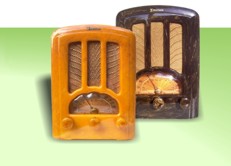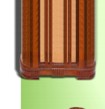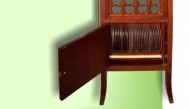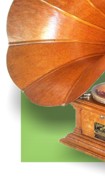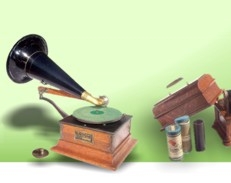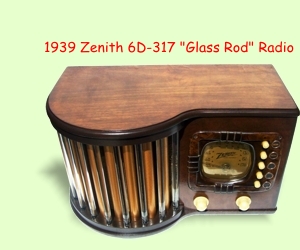|
In a Nutshell
This is the way to play Pathé Records: unobstructed by a cabinet and/or louvers you can enjoy to the full the pure tonality of the music and glaze at the beauty and spartanic technical simplicity of its reproduction

[DIFFUSOR PATHÉ Breveté Sans Garantie Du Gouvernement]
Introduction:
Charles Morand Pathé [1863-1957] was a French industrialist and film pioneer. In 1896 he founded together with brothers Émile, Théophile and Jacques the Société Pathé Frères (Pathé Brothers Company) in Paris, and took the company public under the name Compagnie Générale des Établissements Pathé Frères Phonographes & Cinématographes (sometimes abbreviated as "C.G.P.C.") in 1897. Eventually Pathé became the largest film equipment and production company in the world as well as a major producer of phonograph records. Pathé's phonographs and discs were different from others. Their discs were vertically cut like an Edison cylinder and unlike Victors lateral cut records. The grooves were wider, requiring a permanent ball-shaped 1/32 inch diameter (0.75 mm) sapphire stylus instead of steel needles - no need anymore to replace a needle after playing one record. The records turned at 90 rpm, rather than at 78, and originally started playing at the disc's center spiralling outwards and requiring stronger motors. And they came in six sizes between 7 and 20 inch diameter, that is half a meter.
Long before Pathé came out with the Actuelle and Lumière phonographs a very unique machine was sold around 1920 as the Pathé Diffusor gramophone. It combines the reproducer, tonearm and horn of a conventional gramophone into a simple cone, made from hard paper, tipped by a sapphire ball as stylus. The obvious difference is that music is distributed uniformly to all directions (see however under techies), compared to a horn phonograph or gramophone. Most of the rare versions of this gramophone principle are housed in cabinets with louvers, doors, lids, etc. to let the sound out. Here we have the rarest, minimal, most spartanic, most efficient and most appealing incarnation, the cone sitting openly on a box housing the motor.
For the techies only:
As you can hear from watching the youtube video (pict.23 or ref.4), the volume and frequency response of the sound from the gramophone's cone are (only slightly!) dependent on the position and distance of the camera/microphone, a little louder in front, but with rather uniform brilliance. The gramophone's cone can be compared to a loudspeaker without baffle or box (dipole speaker), radiating in a figure of eight pattern. For wavelengths larger or equal to the membrane size there is a negative interference of the back and the front wave (the very reason for having a baffle or box), that partially cancels the forward and backward peaks of the figure of eight pattern. At very high frequencies the interference vanishes, making baffles unnecessary for tweeters. The wavelength of the 440 Hz chamber pitch coinciding with a typical soprano voice fundamental tone, is about 2 1/2 feet. And even brilliance or treble, caused by harmonics with 10 times higher frequencies, still have a few inches wavelength. Various effects (the aluminum struttings touching the cone (pict.15), cone angle, back geometry, room reflections, etc.) complicate the picture. Last not least many speaker effects are absent here, since we don't have a voice coil suspended in air, but a rigid joint between record surface "driver" and cone. The net effect is some, but little damping and frequency dependence.
Note:
Not all Pathé records are vertically cut. In 1920 Pathé introduced conventional lateral cut discs, still copied using pantographs and marketed as "needle cut" using the name of Actuelle. These records cannot be played with this gramophone.
Additional information:
ref. 1: http://en.wikipedia.org/wiki/Path%C3%A9
ref. 2: http://www.delabelleepoqueauxanneesfolles.com/Pathe1.htm
ref. 3: http://www.dutempsdescerisesauxfeuillesmortes.net/fiches_bio/charlus/charlus_memoires.htm
ref. 4: http://www.youtube.com/watch?v=sGdcjVdBorc
About my gramophone:
The gramophone is in very good condition, visually and technically. The cone paper is original, the apex had some distortions that have been repaired. The "Diffusor" tag and the "Pathé" engraved stylus holder and stylus are all original. The cabinet is not refinished, and sports the original "Pathé" decal. There is an ivory tag with store information on front (pict.11). The motor and crank are original in all parts.
The machine comes with the two original Pathé records (pict.s 21,22), that were used for the youtube video (click on pict.23 or go to ref.4):
1. a 1909 center-start 24 cm dia. Pathé record #2642 "Tout's les femmes" [Chansonnette gaie 1903] - "Allô! Mademoiselle" [1909], sung by Charlus. M. Charlus [1860-1951], with real name Louis-Napoléon Defer, "forçat du gramophone" (galley slave of gramophone) wrote his memoirs "J'ai chanté" (ref.3), after having recorded 80'000 songs
2. a 1916 edge-start 29 cm dia. Pathé record #30385 "How do you do, Miss Ragtime?", Burt Earle with the Anglo-American Orchestra - "Lucky Dog", R. Humphries, Xylophone and Bell Solo. Burt Earle was a well known early ragtime banjoist, comparable to Fred v. Eps and Vess L. Ossman. The record was cut with the pantographic process
Please
e-mail
me (Kris) for any questions, ich spreche Deutsch, je parle Français.
|



